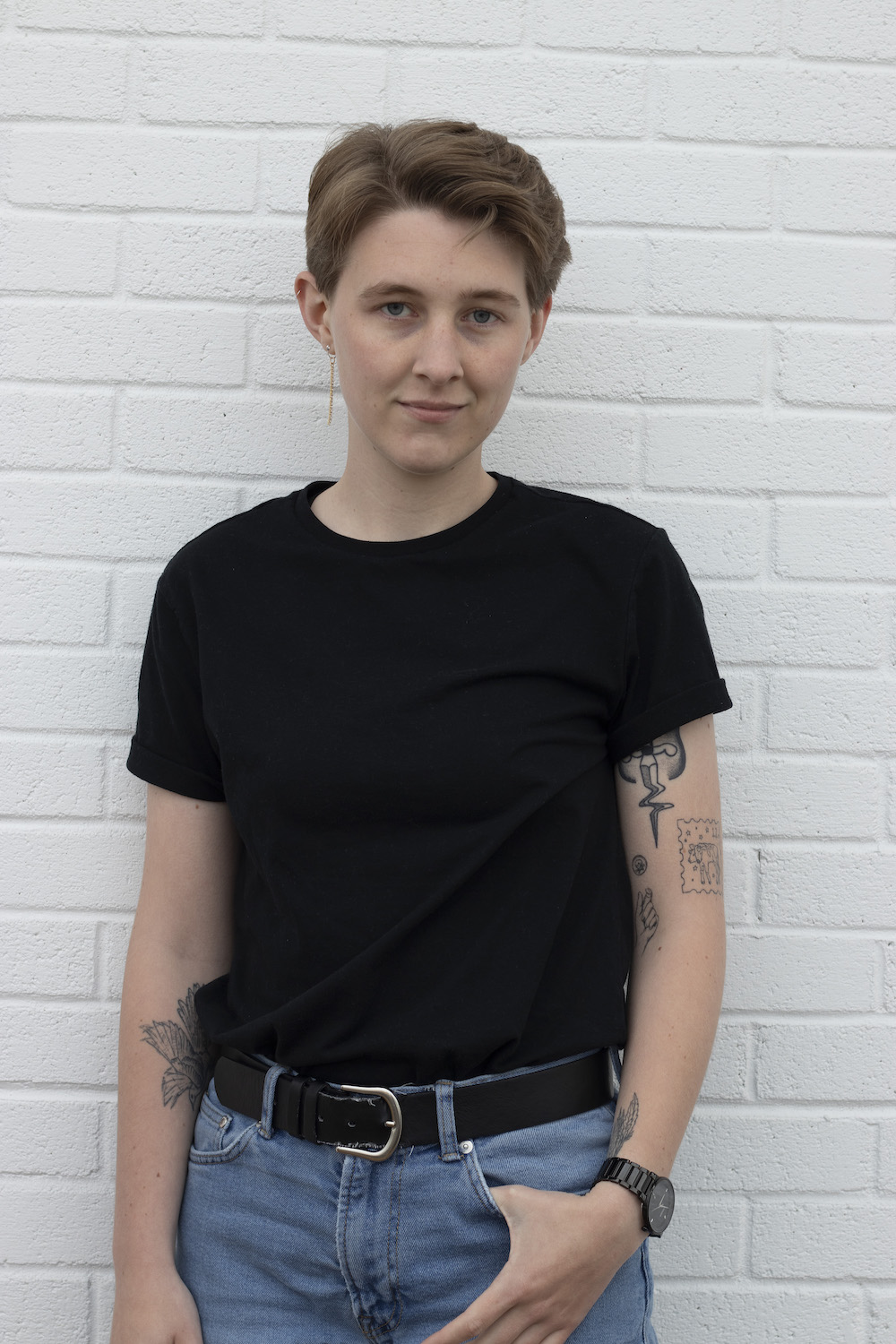Zan Romanoff is sitting at an east LA coffee shop, trying to relax her jaw. She fits right in with the crowd here: it’s populated by creative class professionals with messy hair and expensive denim. Outside, the sky is the kind of damp gray that makes it extra-hard to concentrate. But Zan isn’t looking at the sky. Like everyone else, she’s looking at her laptop.
Zan has a job to do: she’s been assigned to write about how to compose a podcast’s cold open. A cold open is usually a scene that grabs a listener’s attention: it dunks you right into the story. It also introduces the theme and tone of the episode you’re about to hear.
Zan is a professional writer, but this morning, her mind is blank. She can’t come up with any compelling scenes. Maybe because her life is so mundane.
She orders another coffee, and sits down to refocus. She has to make this happen.
Her next paycheck depends on it.
Zan is especially worried about her next paycheck, because working in digital media has been precarious lately. This is the spring of 2023, in the wake of the shuttering of BuzzFeed News, and Vice declaring bankruptcy. What was once a flourishing industry is increasingly thin on the ground. So Zan isn’t alone in her plight. Hundreds of thousands of workers like her are wondering… where’s the money going to come from next?
Okay, we’ll dispense with the meta-bit here. Hi, I’m Zan! I regularly write for Creator HQ about the how-tos of content creation. But I also write scripts for podcasts, including Scamfluencers and Even the Rich. Which means I know a thing or two about how to compose an attention-grabbing, scene-setting cold open. Here are my top tips for writing a cold open that will hook your listeners from the jump.
What is a cold open?
A cold open is the opening scene of a podcast (or a film or TV show) that drops you right in the middle of the action. Because it doesn’t require a lot of lead-up explanation, a good cold open hooks the listener from the get go and leaves them wondering how we got here and what will happen next.
Writing a good cold open is more art than science, but there are a few steps you can take to write the best cold open possible.
Pick your scene
This is at least half the work of writing a cold open. You need to find the exact right moment: something small that still manages to encapsulate all the big themes of your episode. Something specific that also gestures toward the general. Something that’s attention grabbing and interesting, but not overly confusing. It’s a hard balance to strike!
So I start keeping an eye out for cold open material as soon as I start work on a project. As I research and conduct interviews, are there particular quotes that strike me as being especially interesting, surprising, or insightful? Is there a scene I keep returning to as being at the heart of the story, or just an anecdote that I consistently relate to family and friends when they ask how work is going?
Elements of a good cold open
Those are just feelings, though. If you want some more objective criteria to keep track of, consider:
Characters
Who’s in this scene or moment you’re depicting? If your story has a main character, you want them on the page (and in the story) as soon as possible. And ideally, you should let us see them in action. I have a complicated relationship to the adage of show, don’t tell, but in this case, showing is key. You want the person you’re talking about to feel vivid and specific, and having them doing instead of being passively described will help with that.
For instance, check out this 99% Invisible cold open. The episode is centered on how the Netherlands became a biker’s paradise, but it begins with the story of a young Dutch mother witnessing a car accident. That mother, Maartje, is going to be the protagonist of our story, so we start with her at home with her child, about to witness a tragedy.
Timing
Later in that same episode, when we’ve established more about where we’re going, we’ll hear about Maartje’s childhood and how she came to be in that apartment at that moment. But for a cold open, we don’t need to know all that.
Which brings us to another piece of oft-recited wisdom for you: get into your story as late as possible. To find the right moment for this cold open, the team behind 99% Invisible looked for an inflection point, or what fiction writers call an inciting incident. They identified the moment when Maartje’s life changed, and brought us into it with her. So for your cold open, aim for moments of shift, friction, and/or surprise. Ask yourself, what are the expectations of the listener? Of your characters? How is your story upending or confounding those expectations?
Stakes
The most important line in the cold open I wrote for this story is probably “Because her next paycheck depends on it.” That’s the moment when my plight starts to mean something to anyone other than me. (Not much, probably, but at least a little bit.) Because the tale of some writer failing to write is as old and boring as dirt. The story of working towards a much-needed paycheck– now that’s something that many more people are likely to be interested in and relate to. Now the listener has a sense of why I’m determined to write this piece… and what will happen if I fail.
For an example of stakes in action, check out this episode transcript of a Science Vs. about ketamine therapy. We start with the story of Fernanda Graciolla, who’s experienced depression her entire life. Now, not everyone really gets what that means — if you’ve never experienced it, depression can sound like “being sad for a long time.” But we hear from Graciola about how she was too sick to feed herself, and how she and her partner both thought she might not survive much longer before she found ketamine. It’s humanizing and intimate, and it also lets us know that the treatments we’re discussing could be the difference between life and death.
You want your cold open to give some sense of the scope of what you’re dealing with in this story, be it making a little bit of money or saving your own life. Remember, though, that huge stakes don’t necessarily mean much unless we care about the character who’s achieving them. So introducing us to someone we’re interested in hearing more about — that first point — is still key.
Setup
The best way to know if your cold open is working, however, is by looking at how it’s going to end. Cold opens are also sometimes called teases, and that’s exactly what you want to do as you move out of this opening section: tease us with a glimpse of what’s to come.
Planet Money does this nicely in an episode called Does the US Have Too Many Banks? They begin by setting the scene, placing the listener in a small, regional bank with decor inspired by the local culture. It seems like a fun place to be, but why are we here? Then the hosts pull back to talk about how that kind of smaller bank is a particularly American phenomenon — and one that’s caused them to ask the episode’s titular question. Do we have too many banks?
By the time your cold open is wrapping up, the listener should have met someone (or multiple people) they want to hear more about. And that person or people should be in the middle of an interesting situation that sets up the major conflicts or themes of your episode.
Write it!
So much easier said than done. Writing a cold open can be a delicate dance: you need to reveal enough information that the listener isn’t confused… without giving away the whole story, or bogging them down with exposition. Let’s return to my example above:
Zan Romanoff is sitting at an east LA coffee shop, trying to relax her jaw. She fits right in with the crowd here: it’s populated by a crowd of creative class professionals with messy hair and expensive denim. Outside, the sky is the kind of damp gray that makes it extra-hard to concentrate. But Zan isn’t looking at the sky. Like everyone else, she’s looking at her laptop.
This paragraph sets up tableaux for the listener. Admittedly, it’s not the most scintillating thing in the world, but you can picture it, right? You feel immersed in the scene and the world we’re visiting. Even if you’re doing hard-nosed journalism, choose just a couple of sensory details to make your scene come alive. But at this point, the listener still doesn’t understand why they’re here, or why they care.
Zan has a job to do: she’s been assigned to write about how to compose a podcast’s cold open. A cold open is usually a scene that grabs a listener’s attention: it dunks you right into the story. It also often introduces the theme and tone of the episode you’re about to hear.
So here, we get into some background details. I try not to tell you too much– how I got into freelance writing, how I feel about it, how my career is going lately. I just want the listener to understand a sketch of who I am, what I’m doing in this scene, and what my goal is right now.
Zan is a professional writer, but this morning, her mind is blank. She can’t come up with any compelling scenes. Maybe because her life is so mundane.
Conflict!
She orders another coffee, and sits down to refocus. She has to make this happen.
Action and intention! You see here that I’m not just going to stare at the ceiling all day — I’m going to try to make this happen.
Her next paycheck depends on it.
Stakes!
Zan is especially worried about her next paycheck, because working in digital media has been precarious lately. This is the spring of 2023, in the wake of the shuttering of BuzzFeed News, and Vice declaring bankruptcy. What was once a flourishing industry is increasingly thin on the ground. So Zan isn’t alone in her plight. Hundreds of thousands of workers like her are wondering… where’s the money going to come from next?
And, at last, the tease. Here’s where you want to pull even farther back and give some bigger context about why this story matters. This isn’t just one girl’s tale of woe! It’s a specific example of a larger issue, which is what we’ll be exploring in what’s to come.
Of course, you don’t have to follow this structure exactly — every show has its own quirks and its own needs. But if you pay attention to these general principles, it should make it easier to figure out how to get started, and write a cold open that will leave people wanting more.







%20(1).JPG)


































